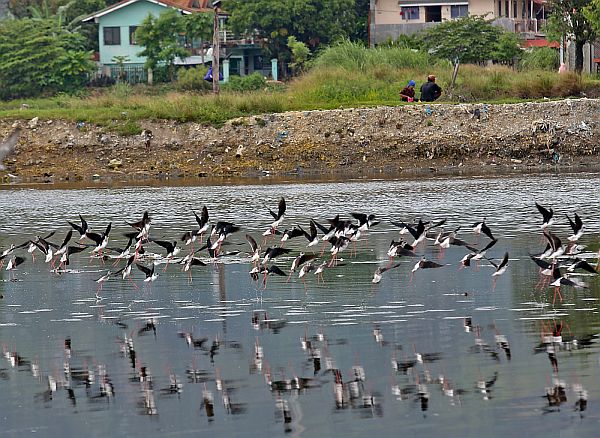
WATER BIRDS AT SRP. Hundreds of migratory birds are seen flying at the river beside the service road of the South Road Properties in Cebu City in this photo taken on Feb. 1, 2017.
CDN FILE PHOTO
The avian influenza, affecting more than 18,000 fowls in Pampanga, may not have reached Cebu; but the provincial government’s veterinary office (PVO) is not taking any chances to ensure the outbreak will not happen here.
The PVO is now closely monitoring specific areas in the towns of Argao and those on Bantayan Island and Talisay City after they were identified as “high-risk” areas where the bird flu virus could most likely propagate, according to PVO officer Louie Maestrado.
Maestrado said their office would also conduct an information and awareness drive to the people not only as means to equip them with knowledge about avian influenza but also to educate them on other equally fatal diseases which can originate from fowls.
“Let’s not hastily conclude a different bird disease as bird flu. It is better if we are informed with the right kind of information. But this does not mean we should be complacent –just report to authorities of symptoms and unusual deaths or sicknesses (of fowls),” he added.
Maestrado stressed that Cebu remains negative of any poultry-related diseases, but he cited the production stage of poultry products as an area of concern.
“We’re also taking a closer look at how owners of poultry farms manage their production. It is possible that the virus may emerge during production process such as unhygienic equipment and placing sick fowls together with the healthy ones,” said Maestrado.
Poultry farms in Cebu are classified by the PVO as areas with medium-risk of bird flu.
Swampy areas
The PVO suspected that the strain of bird flu virus which caused the outbreak in Pampanga in Central Luzon could not be found in the Philippines, and was only brought into the country through migratory birds.
The Department of Environment and Natural Resources (DENR) has earlier urged the public to avoid any contact with migratory birds following the avian flu outbreak in Pampanga.
DENR Biodiversity Management Bureau (BMB) Director Theresa Mundita Lim was quoted by the GMA News Online as saying that “close contact” with wild birds would risk transmission of the avian influenza virus.
“The annual bird migration season in the Philippines is expected to start around September and return to their breeding grounds by March in the following year,” Lim said.
The migratory birds are reported to stop briefly along wetlands such as swamps, marshes, and intertidal and coastal areas, rivers, ponds, lakes, and forests throughout the country to rest and refuel for their journey.
Lim also said that killing or poaching migratory birds could worsen the outbreak.
“We discourage the killing or poaching of the birds because this could just worsen the situation,” she said.
According to the DENR, the Philippines has 117 areas frequented by migratory birds, including the Candaba Swamp in Pampanga, which the DENR has described as an “important staging and wintering area for ducks and other threatened waterbirds.”
In Cebu, Maestrado said migratory birds frequent the swamps, which are commonly found in the places they classified as high risk for bird flu.
He pointed out the ponds and swamps in the South Road Properties (SRP) in Talisay City, the numerous rice fields and fish ponds in Argao town, and the coastal swamps on Bantayan Island as spots in which the risk of bird flu virus is high. Bantayan Island, considered the egg capital of Cebu, is also known for its flourishing poultry industry.
Maestrado also said they are taking note of the flying behavior of migratory birds found in these locations as part of their strategic surveillance to prevent an avian flu outbreak from happening in Cebu.